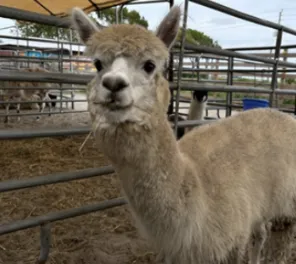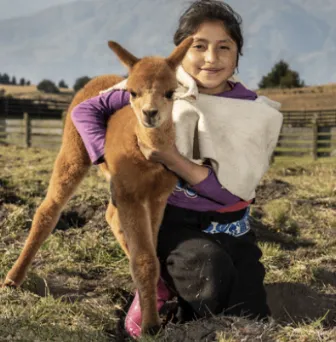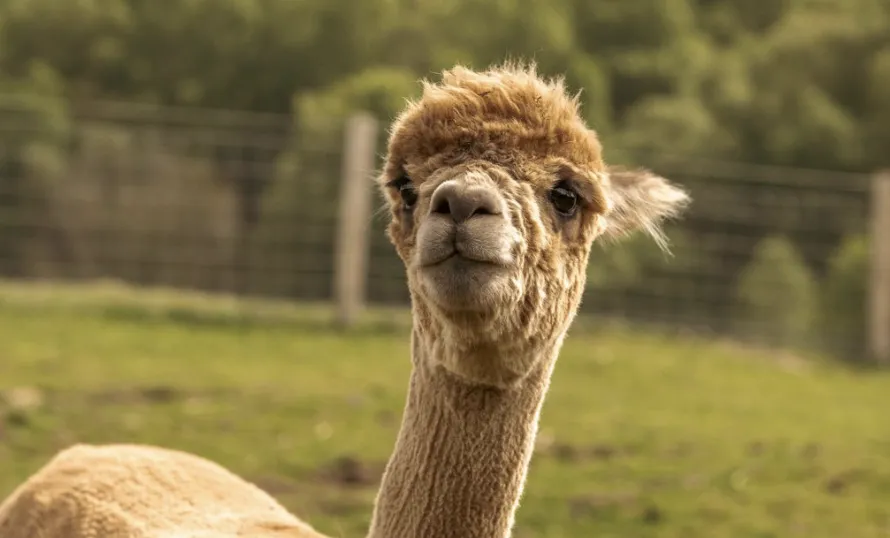


Lloyd the Alpaca
by: Darian Borghei
Guess which animal is the smallest member of the camel family, on average 3 feet high at the shoulder and 4-7 feet long.
If you guessed the Alpaca, you are right!
Overview:
Alpacas (Vicugna pacos) are domesticated camelids, believed to have originated from the Andes region of South America, particularly Peru, Bolivia, and Chile.
They are closely related to llamas, vicuñas, and guanacos, all of which are part of the Camelidae family.
Alpacas are primarily found in the Andean highlands, where they have adapted to live in harsh environments characterized by high altitudes, thin air, and extreme temperature variations.
Their natural habitat includes grasslands, shrublands, and mountainous terrain.
Physical Description: Alpacas are smaller than llamas, with a height ranging from 32 to 39 inches and typically weighing between 121 to 143 pounds. Alpacas have a soft, woolly fleece, which comes in a variety of natural colors including white, black, brown, and grey.
Diet and Eating Habits:
Alpacas are herbivores, primarily feeding on grasses and other vegetation. Their diet consists of grazing on pasturelands and consuming hay. They have a complex three-chambered stomach, which enables them to efficiently digest fibrous plant material.
Behavior and Personality: Alpacas are known for their gentle and docile temperament, making them popular as domesticated animals. They are social creatures and prefer to live in herds, exhibiting strong bonds with other alpacas. Alpacas communicate through various vocalizations, body language,
and gestures to express emotions and maintain social order within the herd.
Domestication and Uses:
Alpacas have been domesticated for thousands of years, primarily for their prized fleece, which is known for its softness, warmth, and hypoallergenic properties. Their fleece is sheared annually and can be spun into yarn for various textiles, including clothing, blankets, and rugs. In
addition to their fleece, alpacas are also valued for their use as pack animals, companion animals, and in some regions, as a source of meat.
Cultural Significance:
Alpacas hold cultural significance for indigenous Andean communities, where they are revered for their role in providing wool for clothing and their importance in traditional ceremonies and rituals. In modern times, alpacas have become symbols of sustainability and eco-friendly
practices in agriculture due to their low environmental impact and renewable fleece production.
Economic Importance:
Alpacas contribute to the economy through the sale of their fleece, breeding stock, and related products. Alpaca farming provides income opportunities for small-scale farmers and rural communities in regions where they are raised.
Conservation Status: Alpacas are not considered endangered, and their populations are relatively stable due to domestication efforts and conservation measures. However, wild relatives such as the vicuña are protected species due to habitat loss and poaching for their prized fleece.
Takeaway:
An alpaca is a great investment in a family’s future! Not only do the animals provide income that helps improve children’s health, nutrition, and their families’ livelihoods, but their presence helps promote land conservation and a rebalance of the indigenous ecosystem. Unlike the hooves of cows and sheep, alpacas’ padded feet protect even fragile terrain from damage. And thanks to the efficiency of their digestive systems, they produce minimal levels of methane. You can make a big difference in the lives of farming families in Ecuador’s Andean highlands by donating today!
